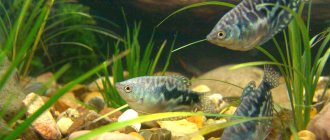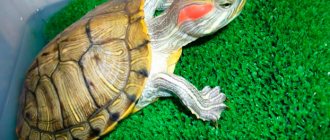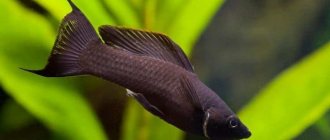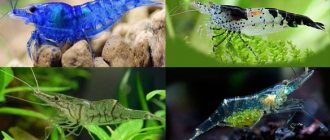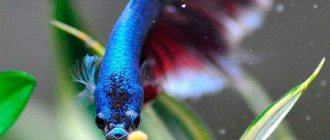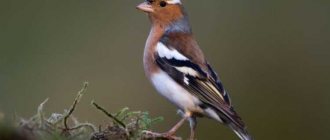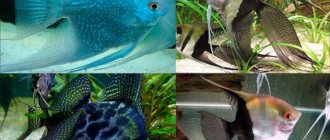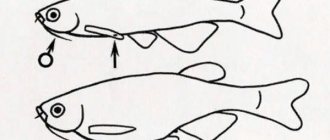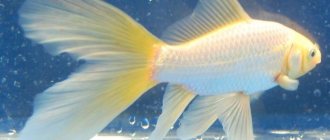A modern home aquarium is not only a stylish interior decoration, but a real separate world with its shady thickets of plants and fast colorful inhabitants.
Often when choosing inhabitants of an aquarium, the question arises of the difficulty of caring for fish or installing additional equipment. Therefore, for a novice aquarist, the optimal solution would be labyrinth fish, the brightest of which are bettas.
This article takes a detailed look at how to care for bettas, what to feed them, and how to tell the difference between male and female betta fish.
Features of labyrinth fish
All species of labyrinth fish are native to swampy lakes and slow, shallow rivers of Africa and Southeast Asia. During the hot season, the water level in such reservoirs decreases sharply, and the oxygen content in swampy water also becomes very low. To survive in such uncomfortable conditions, the ancestors of labyrinthine fish developed a special organ that allowed them to breathe atmospheric air. This organ, called the labyrinth, is located in the head of the fish and consists of a series of plates penetrated by blood vessels.
It is this feature of all labyrinth fish, including betta fish, that makes them the most unpretentious inhabitants of home aquariums.
Betta betta fish
These bright fish with beautiful veil fins were called cockerels for a reason. Male cockerels are outright bullies; they do not tolerate rivalry and attacks on their territory. Observing their behavior, it becomes clear how to distinguish a female betta fish from a male. The male is very self-confident; having noticed an opponent, he immediately straightens his fins, trying to appear larger and changes his color to a brighter one. Moreover, becoming even more aggressive during the spawning period, the male can attack not only a competitor, but also fish of other species. If the aquarium is not large enough or does not have shelter from plants and decorations, serious injuries can occur during collisions.
Female bettas are always less brightly colored and do not have such luxurious long fins. This is one of the main signs by which it is visually clear how to distinguish a female betta fish from a male.
Caring for fry
Betta fry require careful care as they are not known for their survival rate. The food should be prepared a week before the fry appear.
Cockerel fry
For food you will need:
- Ciliates.
- Vinegar eel.
- Artemia.
After two weeks, you need to add a microworm and chopped tubifex to the food. In addition to a properly formulated diet, it is necessary to create comfortable conditions for the development of young animals:
- The aquarium must be equipped with a compressor, since until the age of 20 days, the young animals have not yet formed a respiratory organ;
- The water temperature must be gradually reduced to 22 degrees;
- It is important to perform water changes daily.
As soon as the young animals reach the age of 3 weeks, they must be moved to a spacious aquarium. When the bettas are 3 months old, the betta fish can be distinguished by sex and prepared for spawning again.
Types of betta fish
All the bright colorful varieties of aquarium beauties bettas are descended from their wild counterpart, a nondescript dark olive-colored fish. Sometimes dark stripes and spots were added to the green coloration of wild cockerels.
As a result of long selection, more than 40 different species of betta fish were bred. They differ in different colors, sizes of dorsal and pectoral fins. The size of the fish themselves and even the shape of their body can be different.
But no matter what breed the cockerel is, how to distinguish a female from a male is always clear. Female bettas are smaller in size, always more modestly colored and are not at all aggressive towards members of their species, or towards other fish either.
The most popular types of betta fish
Thanks to many years of selection, there are many varieties of betta fish. But some of them are most commonly found in home aquariums.
- Veiled bettas are probably the most popular species. Their luxurious fins and tail most resemble a luxurious fluttering veil. The color of the scales of this type of cockerel can be very different (blue, red, emerald, even white), most often single-colored individuals are found. It is very easy to understand, looking at a veiled betta fish, how to distinguish a female from a male: the female never has such long fins.
- The double-tailed cockerel is distinguished by double dorsal and caudal fins. The fish of this species are very beautiful; their fins shimmer in different colors in bright light. It is not recommended to house them with active aggressive fish of other species, which may mistake their luxurious fins for prey and bite the tips.
- Royal, or giant, cockerel. This is the largest variety of betta fish, males can grow up to 7.5 cm. These cockerels have fins and a tail of almost normal size, therefore, how to distinguish a female from a male betta fish is not always clear. Differences will only appear in the intensity of color and behavior - females are more peaceful.
- The halfmoon, or crescent-tailed betta, is a gorgeous, brightly colored fish whose spread fins resemble a crescent moon.
The colors of betta fish are simply incredibly diverse: green, red, blue, purple - the variety of colors is endless. In addition, stunningly beautiful two-colored cockerels were bred, with a body of one color and fins of another.
Cockerels of the so-called dragon color look very unusual: they have a single-color body, most often red, and their scales have a pronounced metallic (silver or golden) tint. In the light of aquarium lamps, such a handsome man looks fantastic!
How to distinguish a male from a female in a betta fish and how do they differ? All the above characteristics of bright scales, various colors and beautiful long fins apply only to male bettas. For many years now, aquarium enthusiasts have been trying to breed a breed of cockerels where the females are at least closer to the males in brightness of color, but they are not succeeding. Female betta fish have no distinct species differences at all and are very inconspicuous.
Zebrafish Spawning
This time I am breeding pink danios. There is absolutely nothing new for me. I have live food and a well-established technique for raising fry. I breed these fish because they are beautiful and a grown school should definitely decorate my aquarium. I brought pink danios from the city of Ruzaevka when I was there on a business trip.
Initially, I didn’t plan to buy, but just before leaving I decided to visit a pet store to buy some fish as a souvenir. Since zebrafish are hardy fish, and it took me more than 12 hours to travel home, I chose pink zebrafish. And upon arrival home, I planned to breed pink danios there in Ruzaevka.
Danios are undemanding about the size of the spawning tank, and anyone who bred these fish knows well that you can use just an ordinary three-liter jar for a spawning tank. But this option is considered not preferable because the hatched fry will still have to be moved to a nursery aquarium, and this is associated with a certain risk of their loss.
Well, if that’s the case, then it’s time to move the fry from the jar to the nursery aquarium correctly. There is no need to suffer and catch the fry with a spoon, ladle or net. Also, you cannot pour them out of the jar, but you just need to put the jar in an aquarium in which the water level is higher, then place a hose with a sprayer in the jar and quietly turn on the aeration. A small stream of water will help the fry get out of the jar.
To breed pink danios I will use a 20 liter spawning tank. I will install the aeration and set the heater to 26° degrees, and as a protective net I will use a synthetic rope untangled and crumpled, and then pressed on top with stones.
The net does not cover the entire bottom of the spawning tank, but as they say, this is beneficial and I will not need to eliminate the excess part of the fry. I will place the mesh in the center because I think this is where the middle part of the spawned eggs will be preserved.
Danios can spawn in pairs, but if the males are no longer young, then two or more males are added to one female. In the evening I added one female to four males. Among the selected males there were males with the following color variation: two males of a bright pink color, one with a dark pink tint, and another male with the zebra zebra variation who, for some reason, did not participate in the spawning at all.
The next morning, spawning began. It lasted about an hour, after which I immediately transplanted the breeders into a common aquarium. On the third day the larvae appeared, and on the fourth or fifth day the fry swam.
Keeping betta fish in an aquarium
Cockerels can rightfully be called the most unpretentious aquarium inhabitants, even among labyrinth fish. Caring for them will not cause any trouble even for a completely inexperienced aquarist.
However, this does not mean that there is no need to create suitable conditions for them. Many sellers in pet stores assure customers that a betta fish can live even in a small plastic cup. Maybe, but not for long...
Like any fish, a betta must be able to swim to live. The minimum volume of an aquarium for keeping one betta is no less than five liters. And watching only one fish will be uninteresting even for a child.
Despite the myths about the convenience of round aquariums, low, no higher than 50 cm, rectangular containers are more suitable for bettas. It is advisable that the aquarium be planted and have several shelters where frightened inhabitants can hide.
If you plan to place several betta fish in the aquarium, it is better to choose one (maximum two) males and several females. It is better to buy fish very young; growing up together in the same aquarium, they will be more tolerant of each other. In young cockerels, external differences between the sexes are not yet very pronounced. Observing the behavior of juveniles will help you understand how to distinguish a female from a male in a betta fish.
Diseases
With good care at home, a cockerel can live for about 3 years. But if the aquarium is poorly maintained, overfed or fed with live food, there is a risk that the betta will get sick.
Diseases can lead to the death of a pet, so you should pay attention to the appetite and behavior of the fish, because these are the first signs of any ailment.
Fin rot:
- Symptoms. The edges of the fins first become dull, then erosion appears, which grows intensively over the entire surface of the fin. Then the process of rotting occurs, and the fin disintegrates.
- Causes. The causative agent of the disease is the bacterium Pseudomonas. It occurs due to poor quality or untimely cleaning of the aquarium, when feeding contaminated food or introducing infected fish and plants.
- Treatment is carried out with salt baths and streptocide. It is also important to disinfect the aquarium, change some of the water, and rinse the plants and soil.
Costiosis:
- Symptoms. A gray spot with copious mucus secretion and clouding of the skin are formed.
- Causes. The parasite is caused by a flagellate, which can be introduced into an aquarium with live food or infected fish.
- Treatment is carried out with furazalidone and malachite green. In this case, it is necessary to change the water by 20-30% every day. As a rule, fish recover within a week.
Dropsy:
- Symptoms are a swollen belly, raised scales, redness of the fins and abdomen, loss of appetite, apathy.
- Causes. Incorrect feeding of fish, supplementary feeding, infections.
- For treatment, use Bicillin 5, white streptocide, and a weak solution of potassium permanganate.
Ichthyophthiriasis:
- Symptoms. Small white dots (similar to semolina grains) appear on the fish's head, which spread throughout the body. Lethargy, loss of appetite, swims in jerks.
- Causes. Introduced into the aquarium with new fish or plants. The culprit may also be live food contaminated with ichthyophthyriasis.
- Treatment is carried out with salt baths, malachite green, bicillin 5, antipar preparations.
By following all the recommendations for caring for a cockerel, the fish will delight you with its beauty, absence of diseases and large offspring.
Peculiarities of breathing of betta fish
Like all labyrinth fish, bettas can breathe in two ways. They can absorb oxygen dissolved in water, or they can breathe atmospheric air, capturing it from the surface of the water.
Therefore, if only males will live in the aquarium, you do not need to install an aeration system. But the aquarium must be covered with a lid and a space of at least 15 cm high must be left between the water and the lid. This will allow the fish to breathe air at a suitable temperature and prevent active males from jumping out of the aquarium. This is another sign of how to distinguish a male from a female in a betta fish - the behavior of females is much calmer, and they almost never try to jump out.
Taking care of your health
The lifespan of these colorful “samurai” depends on care and maintenance.
Basic rules for home care, which have already been mentioned above:
- warm, settled water;
- the correct amount of water per individual;
- the presence of a filter, heater, compressor in the aquarium;
- regular water changes (partial);
- special feed.
With proper care, a betta fish can live for three years or even more.
Breeding bettas in an aquarium
Breeding aquarium bettas is not at all difficult; sometimes replacing the water with fresh water or a slight change in temperature is enough to stimulate spawning.
When breeding betta fish, the differences between the female and the male are more than noticeable. Surprisingly, females play a minor role.
The male himself builds a nest of air bubbles on the surface of the water, holding it together with saliva for strength. Small plants that float on the surface (such as duckweed or riccia) can be added to the breeding aquarium to provide the male with additional material for building a nest.
When the nest is ready, a female with eggs is placed next to the male (whether the female has eggs can be determined by the enlarged round abdomen).
After the end of spawning, the female must be removed from the spawning aquarium as quickly as possible; the male will perceive her as a threat to the offspring and constantly attack.
The male takes care of the eggs in the foam nest, and if everything went well, in a couple of days the tiny fry will begin to swim. Then you need to remove the male as well, because he may well mistake his offspring for food.
It is best to feed the fry with small live food, then they will grow quickly and be healthy.
Subtleties of reproduction
How to choose a couple to get the desired offspring
When selecting fish for a pair, you need to pay attention not only to the age, gender, size and color of the fish, it is equally important to be able to assess the condition of the betta. Choosing healthy fish for breeding will allow you to enjoy the contemplation of their relationships, rather than disappointment.
Condition of the fish
When choosing betta fish, the following parameters are assessed:
- The color of the male should be bright. Pale tones indicate illness.
- Fins - only with smooth edges, not torn or broken off.
- The eyes should not be cloudy or bulging.
- The body of a healthy cockerel is smooth, glossy, without scratches, injuries, spots, growths, the abdomen is round and dense.
- An active fish is most likely healthy. You can check this by placing your hand on the wall of the aquarium. If the cockerel reacted with a “fighting stance” and did not tremble or press its fins to its body, then you can safely take it into your aquarium.
Maintenance of breeders before spawning
After the separated couple has spent about two weeks in different aquariums, where each of the bettas fed heavily on live food, the male can be released into the spawning area. As soon as the color of the future parent becomes as bright as possible, and he himself begins to create a nest, a female can be placed with him. At that time, the female should already have a tightly packed abdomen with stripes on the sides, as well as an enlarged ovipositor (“egg” on the abdomen).
The cockerel may become distracted by the female and stop building the nest. In this case, you need to divide the aquarium into two parts with a transparent partition, and after 1 - 2 days it can be removed. If manufacturers are in no hurry to fulfill their functions, it is necessary to check the hardness and temperature of the water.
Cockerel fish: how to distinguish a female from a male
External differences in betta fish begin to appear only at four months of age. Males begin to grow longer fins and a tail. Differences in size also become noticeable: males become larger and more massive. But in some short-tailed species (for example, poster bettas), it is difficult to navigate by the size of the fins. There is one external difference that is noticeable even in young fish.
In the photo, how to distinguish male and female betta fish is clearly visible: the pelvic fin of the male is always thin and long, while in the female it is wider and round. Females also have a more rounded abdomen and often have a distinct white dot visible on their belly. Although young males may also have a white dot on their abdomen before reaching maturity.
Adviсe
- The skill of accurately determining the sex of betta fish develops with experience. Experienced aquarists can sometimes identify male fry even when they reach only 2 cm in length.
- If you have any doubts when determining the sex of a fish, try to consult a fish specialist at a specialized aquarium store. Look for an aquarium store that sells only fish and aquarium supplies, rather than a general pet store.
- If you need to determine the sex of adult bettas, the easiest way is to look at their size. Females usually have a smaller body size than males.
Behavior of betta fish
In addition to purely external differences, cockerels have strong differences in the behavior of males and females. Males, even young ones, are extremely jealous of members of their own species; fights between them for territory and the attention of females can be very cruel.
In the photo of a betta fish, how to distinguish a female from a male is immediately noticeable. The male spreads his fins and outwardly even increases in size. The color of the scales of an angry male becomes brighter and literally shimmers. He threatens his opponent with his menacing appearance and tries to drive him away.
Even in a fairly large aquarium, densely planted with plants and equipped with shelters for fish, a peaceful life between male bettas is not at all guaranteed. There is an opinion that fish that grow up together will be more tolerant of each other, but this does not always work.
Aggressive males, especially during spawning, can attack not only an opponent, but even a female who is not ready for reproduction.
The behavior of females is very different: they live quite calmly in a group of several individuals, never divide the territory and almost never attack other fish. Observing their behavior will help you find the difference between a female and a male in a betta aquarium fish.
Zebrafish spawning repeat
When one or a week and a half has passed after the first spawn, it is important to repeat the procedure again.
If you take this lightly, the caviar will become overripe, lose its life-giving properties, and fry will no longer appear from it. It also happens that the female does not want to spawn overripe caviar at all, which is fraught with harm to her health. In nature, each zebrafish produces five to six spawns in a row.
The easiest way to find out that eggs are overripe (or, on the contrary, not yet ripe) is by the behavior of the “girl” zebrafish. After moving to the spawning area, she behaves restlessly and constantly hides from the male in shelters and plants.
If the female is pregnant, but does not want to lay eggs on her own, then it is important to help her with this in a timely manner. If the female’s belly is very rounded and clearly full of eggs, then she still doesn’t want to spawn, then you need to help her shed overripe eggs
This is done like this: the fish is carefully wrapped in wet cotton wool and held tightly with two fingers of the left hand. Then, using the index finger of the right hand, squeeze the caviar out of it.
If the procedure is carried out correctly and the zebrafish is not harmed, it will be ready to spawn again within a week
If the female’s belly is very rounded and clearly full of eggs, then she still doesn’t want to spawn, then you need to help her shed overripe eggs
This is done like this: the fish is carefully wrapped in wet cotton wool and held tightly with two fingers of the left hand. Then, using the index finger of the right hand, squeeze the caviar out of it.
If the procedure is carried out correctly and the zebrafish is not harmed, it will be ready to spawn again within a week.
The most colorful aquarium fish
A novice aquarist may have a question: why keep these quarrelsome, cocky cockerels? They can fight among themselves, offend other fish and jump out of the aquarium...
Despite its slightly problematic behavior, the betta is one of the most popular fish in home aquariums. Their aggressive behavior can be corrected by choosing the right neighbors and providing the fish with the necessary shelters.
And the fantastic beauty of aquarium cockerels, the richest range of colors and absolute unpretentiousness to living conditions rightfully make them the favorites of many aquarists.
general information
The cockerel or Betta splendens, which is translated from Latin as “fighting fish,” is unpretentious and beautiful, but quite aggressive. This typical labyrinth inhabitant is capable of breathing atmospheric oxygen. Bettas and their distant relatives macropods were the first aquarium fish brought to Europe from Asia. Until this point, they had been bred for a long time in Malaysia and Thailand.
Bettas have gained recognition among lovers of home ponds due to their luxurious appearance, interesting behavior and ability to live in small containers. They are also quite easy to breed and crossbreed, resulting in fry with completely new colors and fins.
Bettas can live in small aquariums
Natural habitat
Information about betta fish first appeared in books on ichthyology in 1910. In the wild, they can be found in the south of East Asia, Vietnam and Cambodia, but the birthplace of bettas is Thailand. Their Latin name Betta splendens is derived from the Javanese word Wuder Bettah, and in Asian countries these aquatic inhabitants are most often called pla-kad, which translates to “biting fish”. It is worth noting that in Thailand they are called pla kat Khmer, which in Russian means “biting fish from the lands of the Khmers.”
In total, more than 70 varieties of cockerels are known, another 10 have not yet been studied or systematized. The genus Betta includes two groups of fish. Representatives of the first of them raise offspring in nests made of foam, and participants of the second carry fry in their mouths.
Cockerels prefer habitats with standing water
In their natural environment , bettas prefer to occupy stagnant lakes or reservoirs with slow currents and dense vegetation. They settle in canals, ponds, rivers and even rice fields. Thanks to their ability to breathe atmospheric oxygen, fish can survive even in harsh conditions.
Cockerels have been dubbed fighting cockerels because of their aggressive behavior. Males regularly engage in fights, which often end in the death of one of the participants in the battle. Wild representatives of the Betta genus were actively used in Thailand for fighting in order to entertain everyone.
Despite their wild nature, these fish take fights seriously. If one of the opponents rises to the surface to take a breath of air, his enemy will patiently wait for his return and will never attack on the sly. If three males are involved in a conflict, then one of them will stay on the sidelines and calmly wait for his turn until one of the fighters dies or is exhausted.
Bettas take fighting very seriously.
Description of cockerels
The wild form of betta fish is not distinguished by its decorative appearance. Its representatives have an elongated body, short fins and brown or greenish scales. However, domestic bettas are very different from their counterparts - they have chic and voluminous fins, with which the fish can catch on snags or algae and damage them.
Of course, decorative bettas have retained the cantankerous character of their ancestors, but at home they are kept not because of their fighting qualities, but for their chic appearance. Some artificially bred species are even considered collectibles and have such a variety of colors and fin shapes that it is impossible to list and systematize them.

